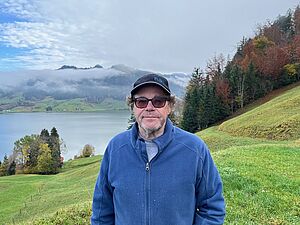"Biodiversity is often destroyed unnecessarily"
Voices on biodiversity
Franz Steiner works at FiBL and recently joined the board of Bioforum Schweiz. He has been committed to biodiversity for many years. (Photo: Brigitta Steiner)
Franz Steiner grew up on a farm. After his agricultural apprenticeship, he studied at the Technical Centre for Tropical Agriculture in Basel, had various jobs as a development aid worker and worked in Switzerland from the 1990s as an organic inspector and agricultural consultant, among other things. Even at the age of 70, he still works at FiBL and recently joined the board of Bioforum Schweiz. He has been committed to biodiversity for many years.
Why are you so committed to biodiversity?
Franz Steiner: My eldest son has a cognitive impairment. When my wife was pregnant, we lived in Peru on the edge of a cotton field where, among other things, the insecticide lead-arsenic was regularly sprayed, sometimes by aeroplane. The notorious herbicide paraquat (product name Gramoxon, editor's note) was also still used there. I only realised the scale of the problem when Professor Ernst Keller from the ETH in Zurich came to visit. He was completely taken aback when he saw the planes. Our son's impairment is almost certainly related to these pesticides. For me, the fact that these effects are still partially ignored today is similar to ignoring the biodiversity crisis.
Can you explain this in more detail?
It is clear to me that the more chemicals, the less biodiversity. In many cases, spraying is superfluous and biodiversity is destroyed, for example on rock piles or in the Alps.
Where do you see the greatest deficits in the promotion of biodiversity in Switzerland?
In and of itself, there are relatively many biodiversity areas and a lot of good is being done, there is not necessarily a lack of biodiversity. But what really bothers me is that if you stand up for biodiversity as a farmer, you are attacked by opinion-makers as a green fundamentalist. I know of a case in my family where the flag for the biodiversity initiative was taken down again because the neighbours were so negative.
You are particularly focussed on alpine pasture management. Biodiversity is not under any particular pressure there, is it?
Yes, in the intensive, low Alps it is. There are fewer problem plants higher up. During the first alpine inspections, which were ordered due to the increased contributions from 2016, the alpine inspectorate received instructions on which plants to treat with which herbicides. At that time, for example, the stinging nettle had to be combated. But where do you find the caterpillars? On the nettles. Nettles are also a good food and medicinal plant. Instead of using chemicals, we walk around our alp with a scythe; dry nettles are very popular with cattle. The biggest biodiversity problems are on alpine pastures with dairy cattle. The cows there are often far too heavy, and tonnes of concentrated feed are carted up, which leads to a higher amount of farmyard manure. And what happens then? The areas are completely over-fertilised with negative effects on biodiversity.
In connection with the biodiversity initiative, on which the Swiss electorate voted "no" in September, farmers were concerned about the obstruction of construction activity and overly strict farming rules - do you have any sympathy for this?
I don't know where these fears came from -- they were simply interpreted into the initiative text. Some absurd things were claimed, such as that all roofs had to be greened.
Agriculture is already doing a lot, so shouldn't the rest of the population be thinking about promoting biodiversity?
What should they do?
For example, greening their rock gardens...
I have a fairly natural garden myself, which is always a source of discussion. People often say that it lacks order. But if you have lots of different plants, there is simply no order like on an English lawn. The same applies to the Bioalp -- because of the many different plants there is "no order".
Interview: Adrian Krebs, FiBL




